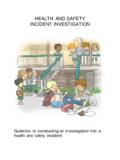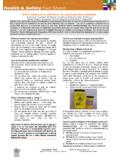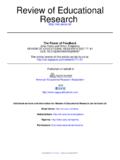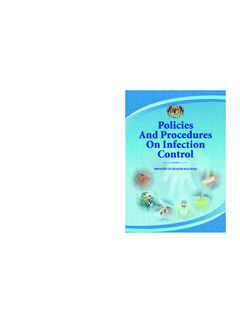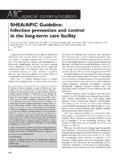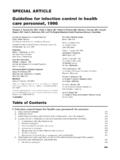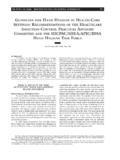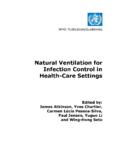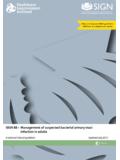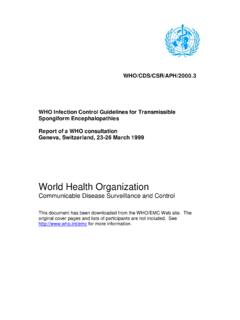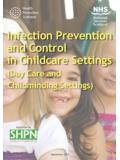Transcription of Infection Control Guideline - Education Queensland
1 Infection Control Guideline To be read in conjunction with procedure: Infection Control Uncontrolled copy. Refer to the Department of Education and Training Policy and Procedure Register at to ensure you have the most current version of this document. Page 2 of 29 Contents [Navigate this electronic document using blue hyperlinks] Page 1. Why do we need an Infection Control Guideline ? 3 2. Who Funds Infection Control ? 3 3. The Nature of Departmental Workplaces 4 4. Infection Control Program 5 5. Hazard Identification - Infectious Conditions Summary Table 6 6. Assessment of Risk 7 7. Standard Precautions 8 8. Facilities, Amenities, Equipment, Personal Protective Equipment, and other items 10 9. Protocols for Infection Control 11 Individual s Responsibilities for Infection Control 12 Hand Hygiene 13 Infectious Diseases in the Workplace - What to do? 14 Contagious Conditions and the Public Health Act 2005 (Qld) 15 Spills Management blood and bodily substances 16 Preventing needle stick injuries (including discarding needles and syringes) 18 Direct Exposure to Blood or Bodily Substance Including What to do if a Needle Stick Injury Occurs 19 Infection Control in Sport 20 Cleaning of the Work Environment 21 Infection Control in Curriculum 24 10.
2 Vaccination / Immunisation 25 11. Education and Training 28 12. Pandemic Planning 28 13. Additional Resources 29 Uncontrolled copy. Refer to the Department of Education and Training Policy and Procedure Register at to ensure you have the most current version of this document. Page 3 of 29 1. Why do we need an Infection Control Guideline ? Infectious diseases can have a significant impact on workplaces through absenteeism, disruption of services and the interruption of learning in the school environment. This Guideline provides information on adopting an Infection Control program which involves undertaking a comprehensive risk management strategy. What are infectious diseases? Infectious diseases are diseases you can catch from a person, an animal, an insect, the environment or contaminated food and water. Most infectious diseases are spread by a single, well-defined route. Understanding how they spread helps determine the best prevention methods.
3 Modes of Transmission the common ways diseases spread are: Contact transmission when a person is exposed to an infectious agent from direct contact with infectious blood or body substances blood, urine, faeces, saliva, nasal secretions, or from indirect contact with contaminated items such as surfaces and equipment door handles. Infectious agents can then enter the person s body via broken skin cuts, the mucous membranes of the person s eyes, nose or mouth, by ingestion the faecal-oral route or by a sharps needle stick injury. Droplet transmission when infectious agents contained in large droplets splash, spray, spatter of blood or body substances are deposited on the mucous membranes of the eyes, nose, mouth etc. Airborne transmission when infectious agents contained in aerosols and dust are inhaled. Food-borne transmission when infectious agents are spread through consumption of contaminated food.
4 Water-borne transmission when infectious agents are spread through consumption or contact with contaminated water. Vector-borne transmission when insect vectors such as mosquitos and ticks transmit Infection to a person via bites Dengue Fever. What Do We Have To Do? The Work Health and Safety Act 2011 places a duty to ensure health and safety, so far as is reasonably practicable. Infectious diseases are a known hazard in the workplace. Staff must be advised of infectious disease hazards, risks and how to implement controls including recommended vaccinations for those who work with children. Certain infectious diseases caught by workers as a result of the workplace are required to be notified to Workplace Health and Safety Queensland . The Work Health and Safety Regulation 2011 requires workplaces to manage health and safety risks, including occupational Infection risks. It also requires workplaces to: Provide adequate and accessible facilities that are in good working order, clean and safe.
5 Provide first aid equipment and services. The Public Health Act 2005, places responsibilities on the department to provide safeguards that protect and promote the health of the Queensland public, including controlling the spread of prescribed contagious conditions that may make children sick and then spread into the broader community. More information on the application of the Public Health Act 2005 is provided through the procedure Management of Prescribed Contagious Conditions. 2. Who funds Infection Control ? Funding for processes, facilities, materials and equipment to implement Infection Control practices are sourced locally within workplace budgets, including the costs for vaccination of staff for work related diseases. Departmental workplaces are not responsible for funding student vaccination. Uncontrolled copy. Refer to the Department of Education and Training Policy and Procedure Register at to ensure you have the most current version of this document.
6 Page 4 of 29 3. The Nature of Departmental Workplaces Some factors that increase the risk of infectious disease spread in departmental workplaces include: Work with children Some infectious diseases may spread more readily where there is close contact between children, and between children and adults, in Education services. Childhood factors such as age-related immunity and ability to follow hygiene practices, including hand hygiene and cough etiquette, may contribute to the spread of Infection . Groups of people, in close contact for extended periods on a daily basis Open plan offices, staff rooms and class rooms, school assembly and other functions place departmental staff and students in close contact with others for extended periods of time. Infectious diseases may spread from person to person via one or more of the known routes of transmission. Culture of attendance at the workplace when unwell Staff and students often attend work/school when feeling unwell but well enough to work.
7 However, they may also be infectious and may pass their illness on to others. Contact with asymptomatic carriers Some people can be infected with an infectious disease without showing signs of illness, or may be infectious for a few days before becoming ill. Some populations, children, may experience a milder illness than adults. In these instances, an infectious person may appear well and will legitimately attend work or school without knowing that they infectious to others. Non-vaccinated populations While Queensland overall has a good rate of vaccination, there are some geographical areas that are lagging with respect to childhood immunisation. Adults can also acquire diseases if they were not fully vaccinated as a child ( measles), were not exposed to infectious diseases during their childhood ( chickenpox), or if their immunity to infectious diseases from previous Infection or vaccination has waned , whooping cough (pertussis).
8 Poor respiratory hygiene Some infectious diseases are transmitted via droplets or aerosols which are produced when sneezing and coughing. Poor respiratory hygiene enables these diseases to spread easily. Workplace activities and duties that increase the risk of exposure to infectious agents The nature of departmental working and learning environments places staff and students at an increased risk of coming into contact with infectious agents due to the activities and duties. Contact with respiratory droplets may occur in the office or classroom, contact with blood and body substances may occur when rendering first aid or during other activities such as feeding or toileting in a special Education environment, during cleaning of facilities and grounds maintenance. People can also contract infectious diseases from animals (zoonosis) that enter the workplace ( petting zoos), or that may be used as part of the Education curriculum ( agricultural studies) or which are encountered during educational visits ( farm visits).
9 The environment and the work location In Queensland , some communities may experience an increased prevalence of some types of infectious diseases due to factors such as geographical location or extreme weather events. For example, some locations may be more prone to mosquito-borne diseases such as Dengue. Heavy rain and flooding can cause contamination of the school grounds with infectious agents associated with sewage, rodents, animal excreta, mud and surface water. Uncontrolled copy. Refer to the Department of Education and Training Policy and Procedure Register at to ensure you have the most current version of this document. Page 5 of 29 4. Infection Control Program There are many and varied infectious disease risks within our workplaces. The implementation of a comprehensive Infection Control program can prevent or minimise the spread of infectious disease at the workplace. It can also prevent an infectious disease from spreading to the broader community.
10 The procedure, Infection Control , requires departmental workplaces adopt and follow an Infection Control Program that is developed in response to the specific hazards and risks of the particular workplace. The following is an explanation of the structure of an Infection Control Program. * Use the interactive hyperlinks to navigate to relevant sections. Risk Management is a planned, systematic process to address all reasonably foreseeable hazards and associated risks. It fosters continuous improvement and is adaptable to rapidly respond to change as required. Risk management is to be used in the development, customisation and review of a workplace s Infection Control program Hazard Identification What infectious diseases could occur at the workplace? How is each infectious diseases spread? Assessment of Risk What is the likelihood and consequences of exposure? How could this happen? Determining Controls How to Control the risks?
